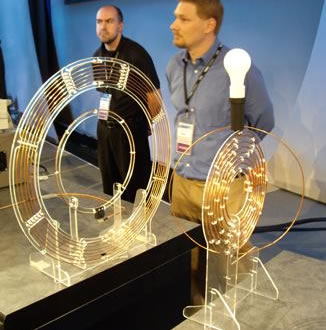Intel is working on a way for your laptop to get not just data wirelessly, but power as well. The company claims to have made progress in increasing the efficiency of a technique for wirelessly powering consumer devices.

(Intel wireless demonstration - light bulb powered without wires)
Magnetic fields are used to broadcast up to sixty watts of power for short distances - two or three feet. Only 25% of the power is lost in transmission.
“Something like this technology could be embedded in tables and work surfaces,” said Justin Rattner, Intel’s chief technology officer, “so as soon as you put down an appropriately equipped device it would immediately begin drawing power.”“In the future, your kitchen counters might do it,” Mr. Rattner said. “You’d just drop your espresso maker down on them and you would never have to plug it in.”
The project is being led by Joshua R. Smith, an Intel researcher in Seattle, Washington. Marin Soljacic, an MIT physicist, pioneered the original technique, called resonant magnetic fields. Read more about this technology in an earlier article - Wireless Power For Laptops, Cellphones?
The idea for wireless power transmission was first suggested by Nicola Tesla. Science fiction writers eagerly seized on the idea in the early twentieth century. In The Mightiest Machine, a novel serialized in Astounding Science-Fiction in 1934, the technology makes an appearance:
Aarn pushed a second standard into view, which was surmounted by a metal bowl that closely resembled a deep soup dish. The inner surface was evidently a parabolic one, made up of a maze of tiny coils, each oriented carefully toward some definite aim, while the entire rim of the "soup dish" was a single larger coil. Carefully Aarn adjusted it so that it pointed toward the flickering cage of copper wires, and beyond it to the apparatus at the other end of the bench. This apparatus seemed fairly simple, merely a number of standards with various arrangements of wires. Two parallel copper bars, a double spiral made of two insulated wires, two metal disks.
No comments:
Post a Comment